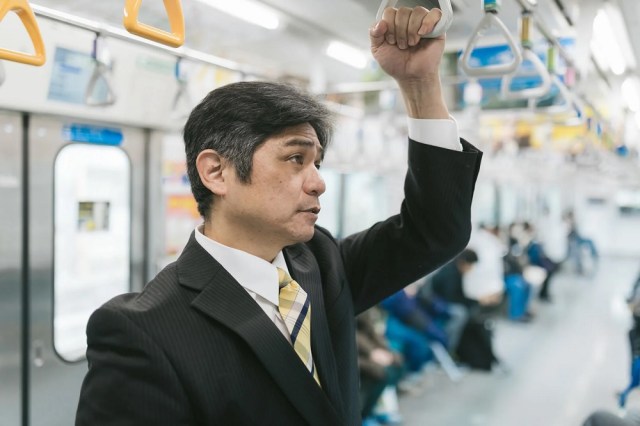Japan Weak Men’s Center suddenly cancels men-only train event

All-men carriage would have been organization’s first outside of Tokyo.
Many commuter train lines in Japan operate trains with women-only carriages on a daily basis during the morning and evening rush hours, as a countermeasure against gropers, or chikan, as they’re called in Japanese. Chikan use the crowded conditions onboard commuter trains as cover for their heinous acts, making it difficult to identify or confront the perpetrator before they exit the train and make their escape, and so women-only cars are offered as an option for female passengers who feel more at ease with no men in their vicinity.
However, a non-profit organization called the Japan Weak Men’s Center has, for the last few years, organized a men-only train. The organization insists that this is not a form of protest against women-only train cars, having previously issued a statement establishing its opinion on the matter as “Women-only cars are absolutely necessary so that they can feel secure and safe while riding. Such cars should be provided not just at rush hour, but at all times.” Instead, the professed goal of the Japan Weak Men’s Center’s men-only train initiative is to raise awareness that men too can be victims of groping and other forms of sexual harassment or assault, as well as the potentially ruinous effects of being falsely or mistakenly accused of groping.
The Japan Weak Men’s Center’s men-only trains run in November, in recognition of International Men’s Day on November 19. Since this is an event organized by the Center, and not an official policy of the rail operator, technically the men-only trains are trains that have been rented out in their entirety by the Center, which then invites interested parties to ride the carriage for free. The Japan Weak Men’s Center has also previously said that despite the “men-only” designation, in truth anyone is welcome to ride (provided there’s space on the train), so long as they’re sympathetic to the group’s cause.
The first four iterations of the November men-only trains were all on the Sakura Tram, also known as the Toden Arakawa Line, a streetcar line that runs in the northwest corner of Tokyo’s downtown area. Due to a scheduling conflict, though, this year the Japan Weak Men’s Center was unable to rent out an entire carriage during their desired time frame. So instead, in September they contacted a rail operator in Osaka City, making the decision to run their first men-only train outside Tokyo.
Initially, the organization’s application was accepted by the rail operator, which runs a streetcar network, but in October the operator contacted the Japan Weak Men’s Center and said the group would not be allowed to rent out a train. The Center had been braced for this, as a similar situation had occurred when it applied to run its first men-only train in Tokyo, requiring compromises and adjustments such as an increased security staff presence. After renewed negotiations with the Osaka rail operator, the Japan Weak Men’s Center was once again granted permission to rent out a train for their men-only ride, on the following three conditions.
● The Japan Weak Men’s Center is prohibited from mentioning the rail operator’s name in promoting the event.
● The display of “men-only” signs or placards inside the carriage is prohibited.
● Media organizations are prohibited from taking photos or videos of the train interior during the event.
That first condition might sound like a complete deal breaker, but it’s actually not as big an issue as it seems. In its announcement for the event, the Center simply told anyone wishing to ride its men-only train to meet at a pedestrian bridge near JR Tennoji Station on November 17 by 12:45 p.m., where event organizers would give tickets to the first 30 people to show up (remember, technically the Center is renting out the entire train, so from the rail operator’s viewpoint, it’s already getting paid directly from the Center). After assembling, the group would walk to the similarly named nearby Tennoji-ekimae Station and catch the 1 p.m. train bound for Hamadera-ekimae Station, where the train would then make a U-turn and come back to Tennoji-ekimae Station, with the whole ride lasting about two and a half hours.
▼ Rail route from Tennoji-ekimae Station to Hamadera-ekimae Station
However, on the night of November 5 the Japan Weak Men’s Center suddenly announced, through its Twitter account, that “the Osaka men-only train event planned for November 17 has been cancelled,” and that further details regarding the circumstance of the decision will be discussed at a later time.
As of this writing, it’s unknown whether the decision was made by the Japan Weak Men’s Center or the rail operator, but it’s pretty clear that the rail operator doesn’t want its name associated with the event. The only rail line connecting Tennoji-ekimae Station and Hamadera-ekimae Station, though, is the Hankai Uemachi Line on the Hankai Tramway network, operated by Hankai Tramway Co., Ltd., so it’s not like the company was going to be able to completely disassociate itself with the event.
▼ A Hankai Tramway streetcar
【夜のモ504号車】
夜の早い時間ですが、いつもの帰り道横を走行していました
前照灯、明るいですね#阪堺電車 pic.twitter.com/zIpgk4dW5B
— 阪堺電車【公式】 (@hankai_official) October 15, 2024
Meanwhile, for the Japan Weak Men’s Center’s part, not being able to showcase photos and videos of the event limits its effectiveness as an awareness-raising initiative, so it’s possible that both sides came to see that they weren’t going to be able to work with each other and mutually decided to call the whole thing off.
Source: Sankei Shimbun via Hachima Kiko, Twitter/@jwmc_or_jp
Top image: Pakutaso
● Want to hear about SoraNews24’s latest articles as soon as they’re published? Follow us on Facebook and Twitter!
Credit:


0 comments:
Post a Comment